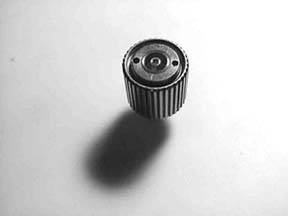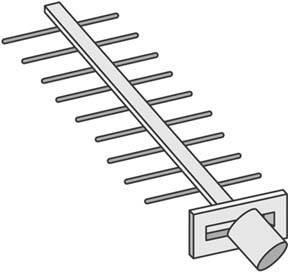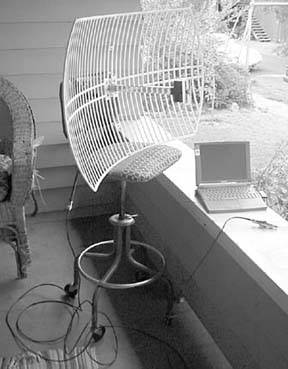Section B.3. Antenna Guide
B 3 Antenna Guide
The single most effective way to extend the range of your access point or client radio is to add an external antenna. Contrary to popular belief, antennas do not give you more signal than you started with (that's what amplifiers are for). They focus the available signal in a particular direction, much like what happens when you turn the focus head of a flashlight. It doesn't make the bulb any brighter, it just focuses what you have into a tighter space.
Figure B-8. APC-7, 7mm

Focusing a flashlight gives you a brighter beam that covers a smaller total area, and likewise, more directional antennas give you a stronger perceived signal in a smaller area. All antennas are somewhat directional, and the measure of their directionality is referred to as gain. Typically, the higher the gain, the better the range (in the direction that the antenna radiates best in).
Another important characteristic of antennas is the phenomenon of polarization [Hack #100].
There are a few general types of antennas suitable for use at microwave frequencies. Each works well for its own application, and no single antenna works best for every application. When shopping for antennas, be sure to look at the actual radiation pattern of the antenna to be sure that it fits your needs.
Plan your goals ahead of time, and configure your network to meet those goals. The following sections describe the most common types of antennas, listed in rough order of increasing gain.
B.3.1. Omni
Omnidirectional antennas (or omnis) radiate outward in horizontal directions in a roughly equal manner. Imagine putting an enormous donut around the center pole of an omni: that's what the radiation pattern looks like. Omnis are good for covering a large area when you don't know which direction your clients might come from. The downside is that they also receive noise from every direction, and so typically aren't as efficient as more directional antennas.
As you can see in Figure B-9, they look like tall, thin poles (anywhere from a few inches to several feet long), and tend to be expensive.
Figure B-9. An omni

The longer they are, the more elements they have (and usually the more gain and the higher the price). Small "rubber ducky" antennas ship standard with many access points, such as the Linksys WAP11 or the Cisco 350. Omni antennas are mounted vertically, like a Popsicle stick reaching skyward. They gain in the horizontal, at the expense of the vertical. This means that the worst place to be in relation to an omni is directly beneath (or above) it.
The vertical response improves dramatically as you move away from the antenna.
B.3.2. Sector (or Sectoral)
Sector antennas come in a variety of packages, from flattened omnis (tall, thin, and rectangular) to small flat squares or circles (Figure B-10). A close cousin of the sector is the patch antenna, which shares most of the same properties. Some are only a few inches across, and mount flat against a vertical wall or on a swivel mount. They can also be ceiling mounted to provide access to a single room, such as a meeting room, classroom, or tradeshow floor. As with omnis, cost is usually proportional to gain.
Figure B-10. A sector antenna, flat and thin

Picture an omni with a mirror behind it, and you'll have the radiation pattern of a sector antenna. Sectors radiate best in one direction, with a beam as wide as 180 degrees or as narrow as you like. They excel in point-to-multipoint applications, where several clients will be accessing the wireless network, all coming from the same general direction.
B.3.3. Yagi
As you can see in Figure B-11, a yagi looks something like an old television aerial. Some yagis are simply bare, like a flat Christmas tree, and are pointed vaguely in the direction of communications. Others are mounted in long horizontal PVC housings. They can work well in point-to-point or point-to-multipoint applications, and can usually achieve higher gain than sectors.
Figure B-11. A yagi

The typical beam width can vary from 15 degrees to as much as 60, depending on the type of yagi design. As with omnis, adding more elements means more gain, a longer antenna, and higher cost.
B.3.4. Waveguides and "Cantennas"
An increasingly popular antenna design is the waveguide. The so-called cantennas are simple antennas for home-brew designers to build, which offer very high gain for relatively little effort. Waveguides most closely resemble plumbing, in that they are boxes or cans with nothing in them but a tiny radiator. Figure B-12 shows an ambitious design, made from extruded and milled aluminum.
The Pringles can and coffee can antennas are examples of simple (but effective) home-brew cylindrical waveguide antennas. A rectangular waveguide can behave like a sector or an omni, depending on how it is constructed.
Figure B-12. A 16 dBi, horizontally polarized waveguide

B.3.5. Parabolic Dishes
In some ways, a dish is the opposite of an omni. Rather than try to cover a wide area, a dish focuses on a very tight space. Dishes typically have the highest gain and most directionality of any antenna. They are ideal for a point-to-point link, and nearly useless for anything else.
Figure B-13 shows a mesh antenna, although solid variations exist. Dishes come as small as 18" across or as big as you like (a 30-foot dish is possible, but probably not very convenient). A dish that can send an 802.11b/g signal more than 20 miles can be as small as a few feet across. In terms of gain for the buck, dishes are probably the cheapest type of antenna. Many people have been successful in converting old satellite and DSS dishes into 2.4 GHz dishes. Generally speaking, the difference between a mesh reflector and a solid reflector has little to do with gain, but is a consideration when mounting your dish, as solid dishes tend to pick up more load from the wind.
B.3.6. Putting It All Together
When trying to estimate what antennas will be required for a particular installation, I find it helpful to draw an overhead picture of the project site. Sketch out where you intend to install your equipment and where you expect your network clients to come from. Also include any obstacles (such as walls containing metal, or intervening buildings and trees on a long distance shot). This should help to determine your desired coverage area, as well as help suggest optimal placement of your access points and antennas.
Figure B-13. A 24 dBi parabolic dish

For example, if you are trying to cover a large office with obstacles in the center (such as an elevator shaft or bathrooms), access points at opposite ends of the room with sector antennas pointed inward might make more sense than a single AP in the center with an omni. On a long distance shot, it might make more sense to go around an intervening tree or building by adding an extra hop, rather than trying to shoot through it with high gain dishes. Knowing the approximate radiation pattern and gain of your antennas ahead of time will help to focus your energy in the direction that you intend to use it, so you can design the most efficient network possible.
Bluetooth, Mobile Phones, and GPS
- Hacks 122: Introduction
- Hack 1. Set Up Bluetooth on Linux
- Hack 2. Set Up Bluetooth on Windows XP
- Hack 3. Connect Mac OS X with a Bluetooth Phone
- Hack 4. Connect Linux with a Bluetooth Phone
- Hack 5. Connect Windows XP with a Bluetooth Phone
- Hack 6. Use Your Treo as a Modem
- Hack 7. Send SMS from a PowerBook
- Hack 8. Remote Control Mac OS X with Bluetooth Phones and PDAs
- Hack 9. Remote Control Linux with a Bluetooth Phone
- Hack 10. Control XMMS with Bluetooth
- Hack 11. Liven Up Parties with a Participatory Slideshow
- Hack 12. Send SMS from Linux
- Hack 13. Remote Control Windows with Bluetooth Phones and PDAs
- Hack 14. Control Your Bluetooth Phone with FMA
- Hack 15. Control Your Computer from Your Palm
- Hack 16. Control Your Home Theater from Your Palm
- Hack 17. Choose a Cellular Data Plan
- Hack 18. Blog from Your Mobile Phone
- Hack 19. Get Google Maps on Your Mobile Phone
- Hack 20. Share Your GPS
- Hack 21. Broadcast Your GPS Position
- Hack 22. Map Wi-Fi Networks with Kismet and GPSd
Network Discovery and Monitoring
- Hacks 2339: Introduction
- Hack 23. Find All Available Wireless Networks
- Hack 24. Discover Networks with NetStumbler
- Hack 25. Detect Networks with Handheld PCs
- Hack 26. Find and Join Wireless Networks with AP Radar
- Hack 27. Detect Networks on Mac OS X
- Hack 28. Scan Passively with KisMAC
- Hack 29. Detect Networks with Kismet
- Hack 30. Monitor Wireless Links in Linux with Wavemon
- Hack 31. Analyze Traffic with Ethereal
- Hack 32. Track 802.11 Frames in Ethereal
- Hack 33. Watch Network Traffic
- Hack 34. grep Your Network
- Hack 35. Check Wi-Fi Network Performance with Qcheck
- Hack 36. Estimate Network Performance
- Hack 37. Get Real-Time Network Stats
- Hack 38. Graph Your Wireless Performance
- Hack 39. Find Radio Manufacturers by MAC
Wireless Security
- Hacks 4051: Introduction
- Hack 40. Stop Moochers from Stealing Your Wi-Fi Bandwidth
- Hack 41. Visualize a Network
- Hack 42. Secure Your Linux Network with WPA
- Hack 43. Control Wireless Access by MAC
- Hack 44. Authenticate Wireless Users
- Hack 45. Forward Ports over SSH
- Hack 46. Proxy Web Traffic over SSH
- Hack 47. Securely Connect Two Networks
- Hack 48. Generate a Tunnel Configuration Automatically
- Hack 49. Poll Wireless Clients
- Hack 50. Interrogate the Network
- Hack 51. Track Wireless Users
Hardware Hacks
- Hacks 5262: Introduction
- Hack 52. Add an External Antenna
- Hack 53. Do-It-Yourself Access Point Hardware
- Hack 54. Boot from a Compact Flash Hard Drive
- Hack 55. Increase the Range of a PowerBook
- Hack 56. Send Power over Your Ethernet
- Hack 57. The NoCat Night Light
- Hack 58. Upgrade the Linksys WET11
- Hack 59. Scan for Wireless Networks Automatically
- Hack 60. Backlight Your Zipit
- Hack 61. Unwire Your Pistol Mouse
- Hack 62. Mobilize Your WRT54G with the WiFiCar
Software Hacks
- Hacks 6382: Introduction
- Hack 63. Build Your Own Access Point with Linux
- Hack 64. Bridge Your Linux AP
- Hack 65. Protect Your Bridge with a Firewall
- Hack 66. Filter MAC with HostAP and Madwifi
- Hack 67. Upgrade Your Wireless Router
- Hack 68. Set Up an OLSR Mesh Network
- Hack 69. Extend Your Wireless Network with WDS
- Hack 70. Pebble
- Hack 71. Wall Off Your Wireless
- Hack 72. Run Your Mac as an Access Point
- Hack 73. Run Linux on the Zipit Wireless Messenger
- Hack 74. Capture Wireless Users with NoCatAuth
- Hack 75. Capture Wireless Users on a Small Scale
- Hack 76. Build an Online Community in Your Offline Neighborhood
- Hack 77. Manage Multiple AirPort Base Stations
- Hack 78. Advertise Bonjour Services in Linux
- Hack 79. Advertise Any Service with Bonjour in Mac OS X
- Hack 80. Redirect Brought to you by Bonjour Ads
- Hack 81. Use a Windows-Only Wireless Card in Linux
- Hack 82. Use Your Orinoco Card with Hermes AP
Do-It-Yourself Antennas
- Hacks 8393: Introduction
- Hack 83. Make a Deep Dish Cylindrical Parabolic Reflector
- Hack 84. Spider Omni Antenna
- Hack 85. Pringles Can Waveguide
- Hack 86. Pirouette Can Waveguide
- Hack 87. Primestar Dish with Waveguide Feed
- Hack 88. Primestar Dish with Biquad Feed
- Hack 89. Cut a Cable Omni Antenna
- Hack 90. Build a Slotted Waveguide Antenna
- Hack 91. The Passive Repeater
- Hack 92. Determine Your Antenna Gain
- Hack 93. Build Cheap, Effective Roof Mounts
Wireless Network Design
- Hacks 94100: Introduction
- Hack 94. Analyze Elevation Profiles for Better Long-Range Wireless Networking
- Hack 95. Build a Wireless Network for the Large House
- Hack 96. Establish Line of Sight
- Hack 97. Calculate the Link Budget
- Hack 98. Align Antennas at Long Distances
- Hack 99. Slow Down to Speed Up
- Hack 100. Take Advantage of Antenna Polarization
Appendix A. Wireless Standards
- Appendix A. Wireless Standards
- Section A.1. 802.11: The Mother of All IEEE Wireless Ethernet
- Section A.2. 802.11a: The Betamax of the 802.11 Family
- Section A.3. 802.11b: The De Facto Standard
- Section A.4. 802.11g: Like 802.11b, only Faster
- Section A.5. 802.16: WiMAX Long Distance Wireless Infrastructure
- Section A.6. Bluetooth: Cable Replacement for Devices
- Section A.7. 900 MHz: Low Speed, Better Coverage
- Section A.8. CDPD, 1xRTT, and GPRS: Cellular Data Networks
- Section A.9. FRS and GMRS: Super Walkie-Talkies
- Section A.10. 802.1x: Port Security for Network Communications
- Section A.11. WPA & 802.11i
- Section A.12. BSS Versus IBSS
Appendix B. Wireless Hardware Guide
EAN: 2147483647
Pages: 178
